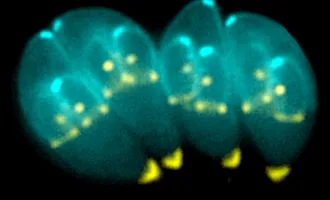Journal Club: Cell Biology, Virology, Genetics, and Neuroscience
CELL BIOLOGY: Load regulates bone formation and Sclerostin expression through a TGFβ-dependent mechanism. Nguyen, J.; Tang, S.Y.; Nguyen, D.; Alliston, T. PLoS One. 8(1):e53813.
Osteoclasts, osteoblasts and osteocytes are three cells that continually remodel our bones in response to daily cues such as physical stresses and mineral availability. Osteocytes coordinate the function of osteoblasts and osteoclasts by secreting hormones such as sclerostin, which inhibits bone formation in response to mechanical stress (such as bearing weight).
While sclerostin is considered a central player in bone regulation, the mechanism that initiates its secretion is not known. Like sclerostin, the molecule TGFβ is also involved in regulating homeostasis of bone formation and degradation, though like sclerostin, it too is poorly understood.
Here, researchers describe how TGFβ prevents sclerostin activation; mechanical stress inhibits TGFβ activity, which is required to keep sclerostin inhibited. Therefore, under stress, TGFβ is downregulated in the bone, sclerostin becomes active, and bone formation is prevented.
VIROLOGY: Delivery of Herpes Simplex virus to retinal ganglion cell axon is dependent on viral protein Us9. Draper, J.M. et al. (Lavail). Investigative Ophthalmology and Visual Science. January 15. [Epub ahead of print]
Herpes simplex virus invades neurons and hides in the cell body during latent (non-symptomatic) infection. During an outbreak, the virus moves to the axon of the neuron and into neighboring cells in the skin, where they create the typical herpetic cold sore. In this paper, researchers wanted to identify the viral proteins necessary for the virus to move from the cell body to the axon of the neuron in preparation for infection of new cells and cold sore formation.
Us9, a candidate protein, was deleted from the virus; the mutant virus was then injected into mouse retinas to determine the efficiency of infection compared to normal virus, as a way to measure how effectively the virus can move from the cell body of one infected neuron into the axon, where it can infect another cell. They found that Us9 and furthermore, a specific region of Us9, was required for movement of the virus to the cell axon in order to infect new cells.
GENETICS: Single-stranded annealing induced by re-initiation of replication origins provides a novel and efficient mechanism for generating copy number expansion via non-allelic homologous recombination. Finn, K.J.; Li, J.J. PLoS Genetics. 9(1):e1003192.
Homologous recombination is the process by which two alleles for the same gene that contain regions of similarity (homology) located on different branches of the same chromosome twist around each other and cause the branches to effectively switch sides (recombine). Recombination can also happen with two similar regions of different genes or even different chromosomes, called “non-allelic homologous recombination,” which often results in the generation of repeated sequences, or “copy number expansion,” in the genome.
Here, researchers characterize a newly discovered mechanism that generates repeated sequences. Normally, DNA can start replication at any “origin of replication” site, which usually are only initiated when the cell divides. However, the researchers found that aberrant “re-replication” initiation easily turns into a form of non-homologous recombination, resulting in duplication of repeated DNA.
NEUROSCIENCE: Genes that act downstream of sensory neurons to influence longevity, Dauer formation and pathogen responses in Caenorhabditis elegans. Gaglia, M.M. et al. (Lee).PLoS Genetics. 8(12):e1003133.
In its simplest terms, the nervous system is meant to tie basic bodily functions with environmental input so as to coordinate life with surrounding circumstances. For example, if your nervous system tells you it is cold, you are moved to find a warmer place, shiver and move blood to vital organs. An interesting way to map neuronal functions with bodily processes is to genetically manipulate neuronal function and observe changes in behavior. This type of manipulation is easy with the model organism C. elegans, a little nematode that is easy to genetically manipulate.
Here, researchers found that deletion of the gene daf10 results in a lack of development and function of many sensory neurons. Accordingly, daf10 deletion also prevented the nematode from properly entering the hibernation-like “dauer” phase of development, in addition to bacterial avoidance.


